#and then for the sequel they could hire actual professional models/actors
Explore tagged Tumblr posts
Text




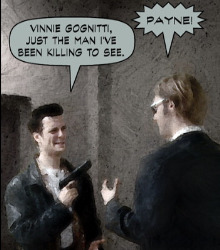
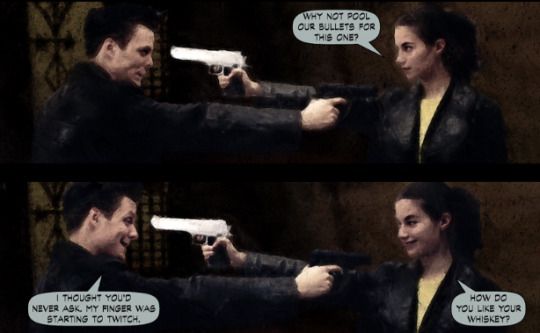
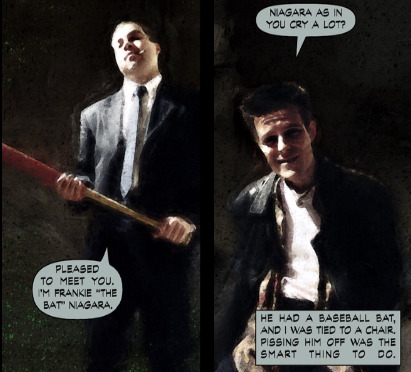
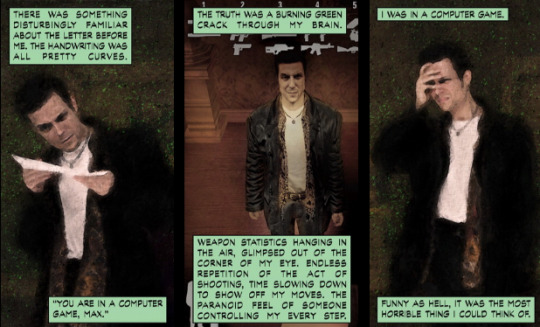




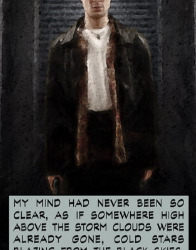

i started playing max payne 2 and was immediately so put off by how he no longer has sam lake's face that i decided to put together a collection of some of the max payne 1 panels that i really liked. enjoy <3
#max payne#max payne 1#remedy entertainment#sam lake#remedyverse#idk depending on how well-designed they are maybe i'll make a post of my favorite max payne 2 panels also#but like. i know literally they had 0 money when making the first game which is why sam lake just used his own face#(also he got his parents to model as woden and horne which is so incredibly funny/based of him to do)#and then for the sequel they could hire actual professional models/actors#but like c'mon. max payne 2 looks like a generic middle-aged dad protagonist of a 2000s action blockbuster#by comparison sam lake has such an interesting face (which if anything fits the raymond chandler film noir vibes even better)#i have very high hopes for the remake(s) that remedy is handling but in a way i hope they keep at least some of the unpolished aspects#anyway sorry y'all the remedy brainworms have gotten me there's no escaping this
95 notes
·
View notes
Link
There is, as happens so often these days, a spectre haunting the imagination of the western left. That specter is most commonly dubbed ”strasserism”, though it has other names, such as ”redbrownism”, ”nazbolism”, or more unwieldy names like ”Angela Nagle leftism”. When I came into the left at the beginning of the last decade, these terms did not exist in any meaningful way. As far as me and the people I knew were concerned, ”strasserite” was an incredibly obscure term used exclusively by online neo-nazis is their petty, internicine conflicts. None of us paid them or their silly ideological totems any heed.
At the beginning of the first half of the 2010’s, the left I was a part of was finally starting to feel hopeful again, after the disorientation and loss of direction that came with the fall of actually existing socialism. During the long winter years of the 90’s and early 00’s, people either hopelessly and bitterly clung to a prophecy that everyone else had now fully discarded, or they tried finding new boutique causes to replace the ones that had failed. To take my native Sweden as an example, two of the more significant new causes were opposing the neo-nazis and opposing globalization. There were some victories – or at least, people liked to think so – but the idea of actually achieving political power was dead in everything but name. The left mostly came to accept the role as the social conscience of liberalism, or in the case of antifascism, fancied itself as the Batman protecting end-of-history Gotham City. The streets of triumphant liberal society might have been gritty, the politicians corrupt and undeserving, but antifascist Batman still rose out of bed every night to protect the craven and the low from monsters lurking in the shadows. Or so they liked to think. Most of the time, they just hung out and drank beer.
…
All the details of the intervening decade are beyond the scope of this essay, but it’s fair to say that the left today is more broken and politically defunct than at any point since the fall of the Soviet Union. In fact, a case can be made that the crisis facing the left today is more serious than the crisis of the late 80s and early 90s. ”Left populism” as a political model has failed. Jeremy Corbyn has presided over the worst labour party showing in nearly a century. The ”Sanders moment” is over, and there’s no sequel to any of these failed left projects anywhere in sight. This decline is likely terminal and irreversible, because unlike the decline in the 90s, the left no longer has any significant working class support. In fact, with each new ”left revival” a la Corbyn, the constant bleeding of working class support only seems to accelerate. Comrade Bhaskar at Jacobin magazine touts the (in)famous AOC as the next new great presidential candidate and hope for global socialism, but anyone with an IQ somewhere north of the melting point of water – or at least, anyone who doesn’t have a paper he’s eagerly trying to sell you – knows that this is a truly desperate flight of fancy that will never come to pass, not in a million years.
…
We first begin with the obvious. Strasserism does not actually exist. Nobody reads the Strasser brothers, not even the neo-nazis who threw accusations of strasserism at each other decades before anyone else. Nobody outside of Russia – and for that matter, nobody inside of Russia – cares about the intellectual output of the National Bolshevik party, if such an output were to be shown to exist. The reason the term strasserism has been brought out from the dustbin of history by the contemporary left is because said left is currently in the middle of a social and political panic, and this panic has at least two central functions. Firstly, panics such as these are one way for a group of believers to deal with a situation where prophecy fails. For the left, the only thing it knows today is constant failure. Like any religious cult, the failure of prophecy can only be redeemed by shedding the blood of those members identified as polluting the faith. The price of social cohesion is the turn toward constant purges.
…
Partaking in this ritual of self-depreciation does not mark you as an outsider. It is only if you break the rules of the game, only if you acknowledge the man behind the curtain, only if you point to the basic truth hidden behind this outer layer of ironic self-mockery that you become one of us, one of the so-called strasserites. This truth is a fairly simple marxist truth. Classes have class interests, and so the idea that you could have a political movement – the left – that was well and truly dominated by one class, yet still wholly committed to the class interests of another class, but also just too bumbling and out of touch to ever do a good job of looking out for the class it supposedly ”really” cares about is, to put it extremely mildly, a dubious idea. It is much more likely that a political movement dominated by one class will also be more or less entirely dedicated to pursuing the class interests of that class, while also being unable to take any strong action that goes against the interests of its dominant class.
…
There was a socialism before Marx, and it was utopian and based on human reason and moral progress. There are good reasons for why this brand of socialism fell out of favor, but within its context one can definitely hold the view that a small class of enlightened and educated well-to-do people, acting out of the goodness of their own hearts, will eventually bring about socialism by lifting up the poor, racist and/or stupid proles. You don’t have to agree with it, but it fits together.
A central premise of marxist, materialist or scientific socialism, on the other hand, is that classes simply cannot act this way. Classes pursue their own interests and act politically not out of greed, or generosity, or any other personal bit of sentiment, but due to historical and economical pressures. It is this very simple fact that makes the ”materialism” of someone like Bhaskar Sunkara at Jacobin magazine, and of most leftists of his stripe in general, so incredibly contradictory. For it to work, there has to be an unstated agreement among the faithful to never seriously use the tools of marxist analysis on the left itself. Any and all self-examination must remain on the level of personal discussion (”can person so and so really be a socialist, when her parents are so rich?”). The punishment for transgression against this agreement, for breaking the most sacred code of Omerta the modern left has, is swift and severe: you will get cancelled for this, and you will be added to the ever growing list of ”strasserites” and ”secret nazis” who tried to lure the faithful away from the true path. What happened to Angela Nagle is instructive in this regard; her article, The Left Case Against Open Borders, was an attempt to argue against unrestricted immigration from a class-based, materialist perspective. It’s quite likely – and also quite amusing – that she would probably have recieved less sustained hate online if she had written that immigration shouldn’t be allowed as long as non-white people talk funny and smell bad.
…
I bring my own example up not to relitigate old battles but to underline the point that the sin that earns people the label of ”strasserite” or ”chud” or ”redbrown nazi” has nothing to do with racist animus, or even the issue of immigration more generally. Conjuring up the threat of racism and the ghosts of Nazi Germany is not done because it is true, but because it is necessary. In my case, having a father who came to Sweden to work from central Africa proved to be an embarassing but fairly minor speed bump on the way to declaring me a fighter for aryan blood purity. There is nothing foolish or irrational about any of this; our esteemed comrades are simply doing the only thing they can do, faced with a contradiction they are unable to resolve and a movement that is rapidly falling apart.
…
While I don’t pretend to speak for anyone other than myself, I would claim that the ”strasserite” class-analysis of politics in the west and the role of the left today has a few central features. To start: as the economies in western countries have shifted over the past decades, a new sort of class of people has sprung up and grown in social and political importance. In the united states, the most common name for this class is PMCs; the professional-managerial classes. Their name is less important than their function and political trajectory. To brutally simplify things for the sake of brevity, the notable feature of many PMCs as political actors is a blend of political liberalism and cultural progressivism, merged with a political project aimed at increasingly subsidizing their own reproduction as a class, ideally by means of state transfers. The state should forgive student debt. The state should dabble in reparations. The state should hire ”ideas people” to write up reports and thinkpieces about reparations. The state should create new racial justice commissions, or just generally create more jobs that can employ people who by dint of belonging to this class feel that them taking a job at Walmart means that capitalism has failed and it’s time for a revolution. The most radical, put-upon and economically insecure parts of this class today naturally gravitate toward the left, because the left is – no matter what leftists delude themselves by saying – a fairly focused, competent and credible class project. When Corbyn came out of nowhere and became Labour party leader, it was a real grassroots movement that brought him there; a grassroots movement of students and people who either have ambition to move up the ladder or a legitimate fear of looming proletarianization, of falling down the social and economic ladder and finding themselves joining the proles.
The particular form of ”pro-worker” rhetoric these members of the PMC use mostly boils down to a sort of charity. Vote for us, and we’ll give you higher benefits and free broadband, Labour recently tried to tell the recalcitrant workers of the north. It didn’t work. This mode of ”charity” is hardly selfless – it would be a free ”gift” from these PMC activists given to their precious salt of the earth proletarians, and like all gifts it would be reliant on the goodwill and generosity of the giver. Its main function would also surely be to feather the ever growing number of nests for this class of comfortable, university-educated administrators. And when some leftists start seriously debating why ”racists” should be denied medical care from the NHS, one starts getting a sense of just how much hierarchical domination their future ”worker’s paradise” promises to deliver to the working poor.
The point here is not a moral one. After Labour lost, one exasperated member and activist despaired over how blind the workers were, how easily fooled they were by tory propaganda. ”Don’t they see how evil capitalism is? How brutal and unfair it is?”, this activist wrote: ”I have many friends with good grades who are stuck working at grocery stores, stocking shelves”. Anyone who pretends to be some sort of materialist cannot in good conscience make fun of sentiments like this; it is completely rational for someone in that position to think that ”the evils of capitalism” are somehow laid bare for the world to see when their friends are forced to stock shelves like a common peon in order to pay the rent. That the other workers at the grocery store probably find this way of thinking completely ludicrous and arrogant is obviously besides the point. Politically speaking, the fury and energy that proletarianization engenders should never be underestimated, because it causes political explosions. Jeremy Corbyn successfully challenged the political cartel that had been running Labour on the back of such a political explosion.
We should not make fun of an activist who despairs at the state of the world when good, solid middle class people with solid middle class grades can no longer achieve the middle class lifestyle they were promised. It is however a basic political truth that a worker’s movement consisting of people who are angry at the prospect social and economic ”demotion” – in other words, people who are fighting against the cruel fate of having to become workers – cannot ever succeed. Promising free broadband, or unlimited Space Communism, or some other stupid fantasy world where getting angry at having to work like a normal person is acceptable because nobody has to work won’t really change that.
…
The grand political divide that sundered the house of modern ”socialism” boils down to the question of which class should have its interests taken care of in the first instance. It is all well and good to talk about ”doing both”, or try to soothe workers by saying that once socialism wins, nobody will work, so they’ll all be taken care of then. A century ago Joe Hill mocked the preachers who tried to placate starving workers by promising them there’d be plenty of pie up in the sky after they were all dead. Today, Aaron Bastani does an even more pathetic job within that vaunted political tradition, promising the british working class asteroid mining and fully automated communist holodecks once The Revolution(tm) succeeds. Until that day comes, though, it can’t really be helped that they’ll have to stay under the thumb of – and fight the battles for – the downwardly mobile professionals, huh? After all, who will build all those fancy asteroid miners if little Junior suddenly has to work at Starbucks like a common plebeian?
This is not a question of left incompetence, or Brexit suddenly wrecking everything, or something that Bernie woulda, coulda, shoulda done. The left is bleeding working class support everywhere. The left is picking up support among the more affluent and well-to-do stratas everywhere. The left is merging with greens and liberal ”progressives” everywhere. This is not incompetence, or cowardice. It is not personal, nor can it be fixed by the actions of individual persons; it is a vindication of historical materialism, and it is playing out right before our very eyes.
It is time for the ”socialism” of the professional and managerial classes and the socialism of the working classes to part ways. The former is moribund and a historical dead-end. The latter, I think, still has a case to be made for it. More importantly – and personal experience from outside the left bears this out – it still has an audience that is willing to listen to it.
…
Workers aren’t stupid. They’re not evil. They haven’t been ”tricked by the media”. They need no false shepherds to guide them, no well-paid moral commissars to teach them to not randomly slaughter their neighbors because of muh racism. They have abandoned the left parties because the left parties have abandoned them, not ”culturally” as some proponents of identity politics would like you to think, but materially. They know their own class interests, and they know that the left is inimical to those interests. This is good news, at least for those of us with the courage and political will needed to help them free themselves from their so-called ”betters”. Let the Labour activists of London lament over how ”disappointed” they are that the working class has stopped following orders. We will not be like you. We will not promise new masters and new yokes to live under, new aristocracies and ”vanguards” to subsidize, new cadres of people selling them moral sermons and sensitivity courses. We will promise them a chance at revenge.
2 notes
·
View notes
Text
Winter Anime 2019 Part 3: High on Concept
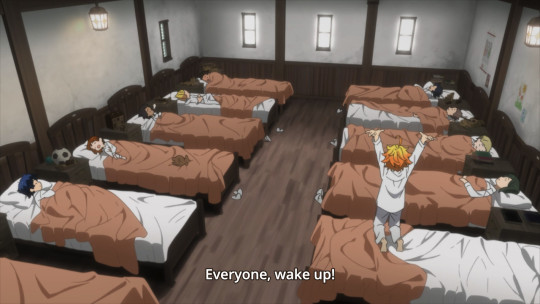
If you wait long enough, you’ll find something good to say.
Doukyonin wa Hiza, Tokidoki, Atama no Ue / My Roommate is a Cat
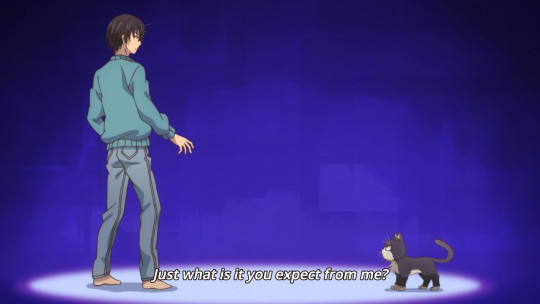
What: Misanthropic mystery author picks up tough stray cat, both get healed.
✅ The cat acts like a cat, the misanthrope acts like a misanthrope.
✅ The approach of telling the same simple story from the perspective of two characters that can’t really communicate effectively is interesting.
✅ This is very basic, but it works. I like both characters, and it's generally inoffensive. Pretty much Barakamon with less of a focus on telling you exactly what to feel. Might watch more of this.
❌ I see we’re now at the point where shows get localized titles that sound like lazy translations of bland Japanese names even when the Japanese title is not that bland to begin with. Lovely.
Dimension High School

What: A bunch of kids press XXX and YYY and are sucked. Wooow.
✅✅ The wraparound segments look extremely realistic. If there was more lensflares and shots of feet I’d almost say someone has finally beaten KyoAni in making anime look like a cheap, egregiously overacted J-Drama.
❌❌ Sadly, the puzzle dimension they end up in just looks like homemade MMD animation, because it is. I mean, at least it’s mocapped, but apparently with a Kinect.
❌❌ E.g., they make jokes about clipping and they kinda have to because everything clips into everything else all the time.
❌❌ Did I mention that all they actually do is solve lame puzzles and fail to be funny about it? It’s really getting to the levels of the dreaded “barely animated voice actor improv podcast” at these points.
♎ Suwabe’s in it, and that’s never an outright bad thing. He’s voicing the quizmaster, in the process proving he’d do anything for a paycheck. I wonder if he has a fiverr acocunt.
Domestic na Kanojo

What: Highschooler loses virginity to one night stand, finds out that it was the sister of the teacher he has a crush on. Incidentally, the mother of both also just married his father. Zany!
✅ This is presented like a low-key, slow drama, and it’s not even bad at that. Some good directing going on here, at least in the beginning.
❌❌ Really just too bad that it’s impossible to take seriously with a setup as contrived as this, not to mention taking it as seriously as it apparently wants to be taken. It’s also not exactly original.
❌ I’m not gonna say that sketchy relationships can’t work (it worked fine for KoiAme, for example), but embedding your suddenly also incestuous pupil-teacher affair in the setting of a harem comedy, complete with other sister walking in on attempted drunk blackout kiss, is not giving me confidence that this has the chops to pull it off.
❌❌ The show this reminds me the most of is Love and Lies, and that’s a real bad calling card to have.
Girly Air Force

What: Girl-shaped fighter jets fall in love with a dude.
❌❌ It’s just another military-hardware-is-cute-girls-actually show in the vein of Strike Witches, the kind where they think that having a few plane CG models is already thrilling content.
❌❌ But then it doesn’t even turn out to be that in practice, because most of the episode is taken up by lame “worldbuilding” (i.e., coming up with excuses for why your fanservice show has to be the way it is) and trying to make your bland harem lead interesting, which is a futile endeavour.
❌ The most interesting part is still the CG dogfighting, such as it is. It’s not great either. Also, girly planes are pink.
♎ Honestly got a laugh out of them randomly picking a Gripen as heroine unit in addition to actual JSADF hardware, because that’s a sleek-looking plane. The biggest prank the JSADF ever pulled on the otaku industry is buying the chubby F-35, which is nowhere to be seen here.
Go-toubun no Hanayome / The Quintessential Quintuplets

What: Empoverished highschooler is hired as a tutor for some rich quintuplets with large breasts.
❌ This is a blatant harem setup that would make a 2003 bishoujo VN blush.
✅ However, in practice it’s much better than it sounds. It knows it’s a wacky romcom with a dumb premise and it does not pretend otherwise.
✅ So it’s lighthearted, but it’s also surprisingly classy. In fact, it’s classier than Domestic no Kanojo, which is a show that’s actually trying to look respectable and failing.
✅ The relationships are also very feisty, with an energy that a comedy needs. There’s a lot of sass to go around here. Probably the best of these I’ve seen in a while, so I’ll give it three eps.
Kemurikusa

What: After getting pulled off the sequel, the Kemono Friends crew made their own version. Presumably there are blackjack and hookers in this show’s future.
❌ If you are a fan of KF’s “charms”, fear not, you would not be able to tell these people made another anime before. It's still total amateur hour.
❌❌ It’s not even the “looks”, though those certainly are not a highlight. The design is okay and the animation is bad, but I’m not incapable of enjoying shows with bad animation. What really kills it is the editing. I usually don’t comment on editing because that’s almost always competent and only very rarely great, but Kemurikusa has uniquely lazy and badly timed editing. Every shot being seconds longer than it needs to be is already an annoyance in low-key dialog scenes, but the alleged action is laughable and allows you a long, unblinking stare at every frame of bad animation. I really do wonder why they even bother with it when it’s so terrible.
✅ The setting seems alright, even though it’s just a reskinned Kemono Friends. At least it’s not gijinka nonsense this time (which makes one wonder where the gimmick characters are supposed to come from, but I digress), and it’s more upfront about what it actually is too. I’d call it mildly intriguing.
❌ I don’t mind mystery and certainly prefer it to exposition bombs, but instead of that this episode quickly establishes the most basic facts... and then repeats them over and over and over some more. Combined with non-editing, this makes for horrible pacing.
♎ I had no opinion on KF’s longer-term qualities, because the first episode was so boring I never got any further. I won’t have an opinion on this show’s long-term qualities for the same reason.
Magical Girl Spec-Ops Asuka

What: Magical girls are tragic, shoot gun’s.
❌❌ Yo bro, what if magical girls but dark? Surely such a thing has never been attempted.
❌ The particular source of grim here is that these girls are war vets and fight with semi-realistic weaponry, so there’s a fair bit of the ol’ milwank in this one as well.
❌ The best part of the entire show is that the enemies they originally fought looked like cute teddy bears. Of course, this is dropped in favor of just slicing and dicing some random terrorists in the main narrative. I guess “dark magical girl” is still too outlandish a concept, gotta go with ripping off The Punisher again.
❌ The characters so far are nothing special, you got your PTSD Rambo and the generically cute tomodachis she swears to protect. Such contrast!
❌❌ If you must make these 80s action movies with some otaku gimmick pasted on top, would you mind making the action look good at least? Because I don’t care how many gallons of blood you paint in your dramatic but conspicuously non-moving pans.
Meiji Tokyo Renka
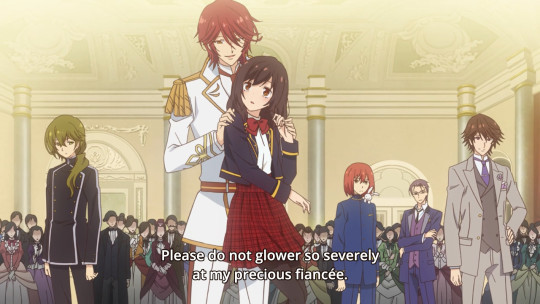
What: Spiritually sensitive lonelygirl gets kitsuned to the Meiji era, which is full of delicious beef and some handsome men too I guess.
✅ This isn’t an outright comedy, but it goes all in on everyone’s fabulosity level to a degree that it’s really already three quarters to Dame x Prince.
✅ Similarly, the lead is not quite as unimpressed with these hams as Ani was, but she certainly has a lot more interest in roast beef than in these guys always trying to pull her into sparkly chin-holding poses &c.
✅ Meiji Tokyo Renka doesn’t seem to be anything special, but it gets the tone right and is expressive enough to not become boring.
♎ While certainly watchable right now, with these there’s always the chance that it decides to launch into real drama in the long run, which in turn almost always goes wrong.
Yakusoku no Neverland / The Promised Neverland
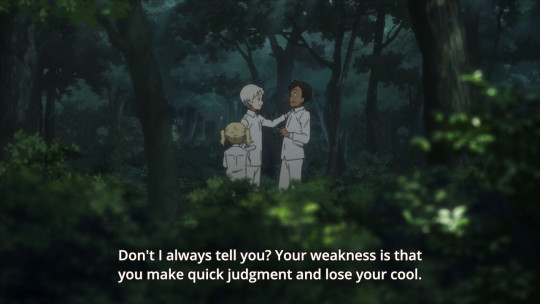
What: An orphanage’s happy daily life gets upended by the realisation that they’re just pizza rolls for some demonic entities.
✅ I watched this right after Kemurikusa and let me tell you, it sure helps if you’ve got professionals on the team. This is a highly competent show as far as cinematography and editing is concerned. While there isn’t any reason to go all out on the action sakuga, this show looks real good.
❌ I’m not feeling the character design, to be specific I think everyone’s chin is too big. This sounds like a real assholy nitpick, but be aware that this will impact around 90% of the time you watch this.
✅ The premise is workable for a shounen manga, even if hardly original (remember Owari no Seraph?) At least it’s not kids with superpowers spamming beams at each other while discussing the nature of heroism, and seems to be going for a more mindgames-based approach in the vein of Death Note. The characters are just barely good enough so far. In the end it’s not so much the premise, but how well the production values are able to sell it. And that’s what Neverland is good at.
❌ It’s specifically a Weekly Shounen Jump manga, and that is huge red flag. Sure enough, while the visuals and mood deliver, the dialog writing justifiably assumes the reader is a moron. Almost every line in this is either straight universe exposition or someone reading someone else’s character sheet back to them. It’s insane and not even necessary because their actions establish all of this just fine, but hey, WSJ readers amirite?
❌ Also, since it’s a successful WSJ property, don’t expect an ending or be prepared to watch this show for years. Most likely both.
♎ This seems like it could be entertaining once the exposition is out of the way and the real meat of the narrative starts. Then again, at that point pacing would come into play, which is yet another achilles heel of WSJ-style shounen manga. Against my better judgement, I’ll probably have a look how this develops, but I don’t expect much.
#anime#winter2019#impressions#meiji tokyo renka#yakusoku no neverland#the promised neverland#Doukyonin wa Hiza Tokidoki Atama no Ue#My Roommate is a Cat#dimension high school#domestic na kanojo#girly air force#go-toubun no hanayome#the quintessential quintuplets#Magical Girl Spec-Ops Asuka
185 notes
·
View notes
Text
27 Rags To Riches Stories That Will Inspire You To Chase Your Dreams
http://bit.ly/2MJFfoC
Cataloged in Stories
27 Rags To Riches Stories That Will Inspire You To Chase Your Dreams
January Nelson Updated September 18, 2018
0
Rags to riches stories are meant to motivate you. They show you that anybody can achieve their dreams, no matter how much money their parents had in the bank account when they were younger or how many dead-end jobs they had to work in order to pay the rent.
27 Celebrities Who Went From Rags To Riches
1. YouTuber Casey Neistat lived on his friend’s couch: Left home and had a kid at ~16, went to New York, lived on his friends couch, made movies with his brother, moved to YouTube, and now is a multi-millionaire who has owned a company.
2. Ed Sheeran had next to no money: Moved to the states trying to make it in music with next to no money and somehow Jamie Foxx saw one of his performances at a small bar. Jamie saw something in him and told him he wanted to help him. Ed slept on his couch for 6 weeks as Jamie did his best to help him in his pursuit of his dream. Jamie got him a gig at the Apollo Theater in NY and if you don’t know the Apollo is a mostly black theater so having white musicians and stand up comics is fairly uncommon. Ed goes on stage with a ukulele in front of a full crowd and performs. Got a standing ovation and a encore. The rest is history.
3. Snoop Dogg was arrested for selling drugs: Snoop Dogg is considered a West Coast king but it wasn’t always an easily won title. Cordozar Calvin Broadus, Jr. was born in California’s Long Beach neighborhood. During a time when the hood was overrun with gang wars, young Snoop had to pick a side. Broadus joined Rollin’ 20 Crips as a teenager and was frequently arrested during his high school years for selling drugs. It wasn’t until he found the outlet of rapping with friends Warren G and Nate Dogg that Snoop took his mind off the streets.
4. The founder of Cirque du Soleil worked on the street: The Canadian-born Guy Laliberté began his circus career busking on the streets: playing accordion, walking on stilts and eating fire. He gambled by bringing a successful troupe from Quebec to the Los Angeles Arts Festival in 1987, with no return fare. The bet paid off, and the circus group was eventually brought to Las Vegas, where they became the world famous Cirque du Soleil we know today.
5. Arnold Schwarzenegger lived without plumbing or a phone: One of the richest action stars of all time, Arnold Schwarzenegger is a seven-time Mr. Olympia with a net worth of $400 million and a resume of movies that earned $4.73 billion at the worldwide box office. He also boasts the title of the 38th governor of California. When he was born in 1947, however, his homeland of Austria was devastated by World War II, and the future “Governator” lived in a home with no plumbing and no phone. Hunger-based riots plagued the streets outside his door.
6. Mark Wahlberg used to sell drugs: The actor dropped out of school at the age of 14 to become a street thug, who sold drugs and indulged in gang wars. Wahlberg also had to serve a 50-day sentence in prison for a violent assault on two men. His current estimated worth is around US$ 165 mn.
7. Eminem had a rough childhood: By ninth grade, he dropped out of high school and decided to pursue music full time. It took performing and local rap battles, working dead-end jobs and creating a crazy alter ego, the famous “Slim Shady,” to get noticed by the likes of Dr. Dre.
8. The creator of Forever 21 worked three jobs: Do Won Chang is the famous face behind Forever 21, who much earlier immigrated to the United States from South Korea, in 1981. Before he founded Forever 21, he worked three jobs simultaneously, as a gas station clerk, a janitor and a coffee shop employee. That period lasted for three years before he founded the company and opened its first clothing store, in 1984. This family business grew quickly by taking advantage of the benefits of “fast fashion.” Forever 21 is now multi-national and has 480 locations across the world. It has also managed to bring in $3 billion per year. And the next generation has been taken into the company, as Chang has brought his two daughters on board.
9. Celine Dion grew up in a poor family: Born the youngest in a family of 14 children, Celine Dion suffered tremendous poverty because her parents could not make ends meet to provide equally to all their children. Nonetheless, ‘her heart went on’ with her love of music. She started performing in small events, slowly acclaiming fame as a teen star with an angelic singing voice. With the support from her loving family, she endeavored to win multiple awards at a young age, and more as she grew up to be a hit singer. Her current net worth of $800 million speaks volumes of what she has achieved in her lifetime, because she had to mortgage her home just to release her first record. It also points out Dion’s never-ending dedication and passion for music.
10. Selena Gomez couldn’t afford gas: Her mother was just 16 years old when she gave birth to Selena and had to work several jobs just to keep a roof over their heads and put food on the table. She also revealed, “I remember my mom would run out of gas all of the time and we’d sit there and have to go through the car and get quarters and help her get gas.”
11. Walt Disney was unemployed for a while: He used to be the cartoonist for the school newspaper. Disney went through the jobless phase where no one hired him, and his brother had to help him out with his job search. He went from rags to riches by starting out with advertisements and going on to animating his own cartoons.
12. Shania Twain sang to put food on the table: Twain was so poor growing up in rural Canada, her parents would have her sing in bars on weeknights to bring in money for the family. She’s also talked about how she and her sister were almost always hungry. Today, Twain is one of the world’s best-selling artists of all time, having sold over 75 million albums worldwide. She is also the best selling female artist in the history of country music, with a net worth of around $350 million.
13. Oprah Winfrey was born into poverty: Winfrey was born into a poor family in Mississippi, but this didn’t stop her from winning a scholarship to Tennessee State University and becoming the first African-American TV correspondent in the state at the age of 19. In 1983, Winfrey moved to Chicago to work for an AM talk show that would later be called The Oprah Winfrey Show.
14. Sarah Jessica Parker was on welfare: The 49-year old actress may be an old timer in the movie industry but long before she found stardom inthe TV series Sex and The City, Sarah Jessica Parker and her family lived on welfare for many years. Growing up in Nelsonville, Ohio, Parker said in an interview that her family seldom celebrated Christmas, birthdays, and other family occasions. She vividly remembers living with no electricity and their phone lines cut because they couldn’t pay the bill. Today, Parker’s net worth has risen to $90 million.
15. Daniel Craig used to sleep outside: The Bond actor Daniel has many critically acclaimed films in his kitty, but according to Hollyscoop, the actor used to sleep on park benches during his struggling days. He is worth an estimated US $65 million.
16. Leighton Meester’s mother gave birth in prison: Leighton Meester may portray the rich spoiled brat Blair Waldorf without any difficulty, but Waldorf’s fictional life is nothing compared to Meester’s actual upbringing. Meester’s mother gave birth to her while serving time in prison and was raised by her grandmother for most of her childhood in Mango Island, Florida. When Meester mother got out, the two went to live in New York, where Leighton started a career as a model. In 2007, they relocated again, this time to Los Angeles, where she eventually managed to get a break in the show business. She is slated to star in three films, set for release this year.
17. Chris Pratt lived in a van: After cutting his teeth playing sidekicks and funnymen, the character actor was immediately promoted to the A-list when he was named the MCU’s Star-Lord, going on to secure gigs fronting 2015’s Jurassic World (and the sequel) as well as sci-fi tentpole Passengers and a Magnificent Seven remake. Turn back the clock to the late ’90s, however, and there were no red carpets and caviar, only shag piles and fleas—he was living in the back of a van with a friend.
18. Tyler Perry was physically abused: He was a victim of physical abuse, courtesy of his father, to the point of him even attempting suicide. Inspired from ‘The Oprah Winfrey Show’, he started immortalizing his life on paper, only to discover the joy of writing and eventually the desire to be a professional story-writer. He then began to create musicals and stage plays on sentimental themes, slowly building himself up to be one of the most successful playwright of modern times. His current net worth stands at $400 million, exemplifying how perseverance can always end up on top.
19. Leonardo DiCaprio lived in a dangerous town: The actor used to live in a seedy LA neighborhood where he saw drugs, poverty, prostitution, and violence at a very tender age. He told , “It goes back to that neighborhood. It came from the fact that I grew up very poor, and I got to see the other side of the spectrum.” Now DiCaprio’s net worth is estimated at $245 million.
20. Mila Kunis acted her way out of poverty: Kunis may be worth $55 million now, but she hasn’t forgotten her roots. She’s even publicly vowed that her and Ashton Kutcher won’t raise entitled children. And we guess the reason for that is pretty clear. It’s because she knows how it feels to be poor.
21. Halle Berry lived in a homeless shelter: The Oscar winning actress ran out of money when she moved to US to become an actress. She even stayed in a homeless shelter. During an interview to , Berry said, “It taught me how to take care of myself and that I could live through any situation, even if it meant going to a shelter for a small stint.”
22. Hilary Swank lived in a trailer park: Long before she became the Million Dollar Baby, Hilary Swank had to endure the hardships of poverty. Growing up, Swank lived in a trailer park back in Washington with only her mother to care for her and her two siblings. Swank’s father left the family when she was young. When her mother lost her job, the family decided to take a chance at life and moved to California. Living in their car, Swank and her family worked on several jobs before they could afford an apartment. Swank’s break came when she got a lead role in Boys Don’t Cry. The award-winning actress now lives well and beyond her former state, with $40 million stashed in the bank.
23. Steve Jobs could not afford college: Jobs was given away for adoption by his biological parents and he became interested in electronics after his foster dad showed him the joys of technical tinkering in their garage. He had to drop out of college, because his education was costing his foster parents a lot. He used to return Coke bottles for money and live on free meals at the Hare Krishna temple. A hippie who used to trip on LSD, Jobs went from a technician in Atari, Inc. to becoming the CEO of Apple Inc.
24. J.K. Rowling dealt with poverty: Born in a lowly English family, Rowling battled depression, suicidal tendencies and poverty to become one of the most loved British authors in the world for her hugely popular Harry Potter series. Highly imaginative as a kid who thrived on stories, she drew from her surroundings and the people in her life as inspirations for the books which have now become one of the biggest movie franchises. From her humble beginnings, she has gone on to become one of the most powerful women in the United Kingdom.
25. The manufacturer of Ray-Ban and Oakley lived in an orphanage: Del Vecchio was one of five children who could not be supported by his widowed mother. After growing up in an orphanage, he went to work in a factory making molds for auto parts and eyeglass frames, where he lost part of his finger. At 23, he opened his own molding shop. That eyeglass frame shop expanded to the world’s largest maker of sunglasses and prescription eyeware. Luxottica makes brands like Ray-Ban and Oakley, with 6,000 retail shops like Sunglass Hut and LensCrafters. His estimated net worth is nowabove $10 billion dollars.
26. Kevin Smith maxed out his credit cards to follow his dreams: Maxed out all his credit cards to make the movie Clerks. If it failed he would have been completely fucked.
27. Jim Carrey lived in a van: Comedian-turned-actor Jim Carrey boasts a net worth of $150 million and a resume of movies that have grossed nearly $4.9 billion worldwide. But before a role on “In Living Color” launched the Canadian comic’s career in 1990, things weren’t so smooth. At 12 years old, the actor was homeless and living in a van after his father lost his job
More From Thought Catalog
Sponsored
Weekend Getaways From NYC: A Perfect Weekend In Upstate New York
Original Article : HERE ; This post was curated & posted using : RealSpecific
=> *********************************************** Read Full Article Here: 27 Rags To Riches Stories That Will Inspire You To Chase Your Dreams ************************************ =>
27 Rags To Riches Stories That Will Inspire You To Chase Your Dreams was originally posted by News - Feed
0 notes
Text
The top 10 Hollywood bulk-ups of all time
Has anyone ever received more praise for getting fat than Robert De Niro? In 1980, the method actor famously gained 60 pounds of flab by gorging himself on pancakes and milkshakes to play bloated ex-boxer Jake LaMotta in Martin Scorsese's Raging Bull. Nearly 30 years later, film buffs are still marveling at his man boobs.
Nothing against De Niro's amazing performance, but Men's Fitness has had enough of critics praising extra pounds.
That's why we're paying tribute to 10 actors who worked their abs for their art—because it takes more effort to curl 80 pounds than it does to gain it.
[RELATED1]
10. Eli Roth in Inglourious Basterds
For his role as a Nazi's worst nightmare in Quentin Tarantino's fantastical World War II flick, the already physically fit Eli Roth needed to step up his game. His character �� Sgt. Donnie "The Bear Jew" Donowitz, a Boston badass who disposes of SS officers with nothing more than a bloodstained Louisville Slugger — isn't the type of guy who would be caught anywhere near Crunch fitness. Instead of getting cut, Roth needed to bulk up. So the Massachusetts native headed home to Beantown, mastered the local accent, stuffed his face with steak, and hit the gym until he packed on 40 pounds of heavy muscle. If you've seen Roth swinging for the fences in the film, you know his dedication paid off.
9. Jason Statham in The Transporter
British actor Jason Statham didn't set out to be an action hero. Starting his career in Guy Ritchie gangster flicks like Snatch and Lock, Stock and Two Smoking Barrels, the former championship diver was best known for playing skinny conmen before Hollywood came calling. So when he was cast as the world's most dangerous chauffeur in the 2002 martial arts flick The Transporter, the part-time model needed a physical overhaul. But instead of going the typical Hollywood route of hiring a personal trainer, Statham motivated himself, increasing his time in the gym and taking his interest in mixed martial arts to the next level. By the end of his intense training, Statham was so physically fit he was able to perform most of his own stunts in the film.
8. Robert De Niro in Raging Bull
Here's the flipside to De Niro's Oscar-winning performance—before he gained the equivalent of a small child to play Jake LaMotta in his darkest, fattest hours, the New York native got completely shredded to play the Italian middleweight pugilist in his prime. But De Niro didn't just hit the treadmill to achieve this look. The GoodFellas star underwent a full-on training routine, working closely with the real-life LaMotta on every facet of a boxer's regiment. In fact, De Niro was so dedicated to becoming a convincing brawler, he actually competed in three organized bouts, winning two. LaMotta was so impressed with De Niro's dedication, he claimed the actor could have fought professionally if he wished.
[RELATED2]
7. Jamie Foxx in Any Given Sunday
Thanks to the Academy Award he nabbed for the 2006 Ray Charles biopic Ray, Jamie Foxx is no longer known as that scrawny dude from Booty Call. But the actor first showed his dedication to his craft in Oliver Stone's 1999 football flick Any Given Sunday. For his role as fictional quarterback Willie Beamen, Foxx hit the weights hard, bulking up to a solid 200 pounds. Then, the former MF cover model reported to football training camp and dropped 25 pounds as a result of the vigorous, real-life training. Luckily, the muscle remained and Foxx ended up with the kind of chiseled physique that looks even better on film. "It made me look bigger on the screen because I was tighter," Foxx told MF.
6. Mickey Rourke in The Wrestler
To take on the role of washed-up grappler Randy "The Ram" Robinson in Darren Aronofsky's 2008 film, Mickey Rourke had to do a lot more than just bleach his hair and wear lime green tights. In order to convincingly portray the kind of guy who could hold his own against King Kong Bundy, the 55-year-old had to pack on nearly 30 pounds of lean muscle. Realizing this could be his comeback role, Rourke dedicated himself to the part, working out religiously and training with professional wrestler Afa the Wild Samoan for months prior to shooting. Rourke pulled it off and his impressive build not only added to the realism of the film, but helped him land a role as a villain in the upcoming Iron Man sequel.
5. Ryan Reynolds in Blade: Trinity
Much like Jamie Foxx, Ryan Reynolds was best known for a not-so-great sitcom (the poorly-titled Two Guys, A Girl and a Pizza Place) before an eight pack turned his career around. When the relatively unknown actor was cast as a vampire hunter in the third film in the Blade trilogy, he knew he needed to do something to grab the audience's attention — after all, he was starring alongside Jessica Biel. So the Vancouver native began to train like a madman, doing everything from intense 3-hour daily workouts to a eating eight to 10 small meals a day. The result? Countless magazine covers, the leading role in the upcoming Green Lantern flick and a marriage to Scarlett Johansson. If that's not motivation to get into the gym, we don't know what is.
[RELATED3]
4. Edward Norton in American History X
Before he knocked audiences on their asses with American History X, Edward Norton wasn't much more than a solid actor with a bad haircut and few decent flicks under his belt. Then he stomped onto the screen as Derek Vinyard, a raging neo-Nazi skinhead with the kind of physically imposing look that would make most men cross the street. Norton didn't just have the cut biceps and chiseled chest of a typical Hollywood leading man, he looked like a guy who had spent some time lifting weights in the joint. So how did the scrawny Ivy Leaguer go from Yale grad to jail bird? A high protein diet mixed with strength-building exercises like squats and presses. If only Norton could've manned up like that in Fight Club.
3. Christian Bale in Batman Begins
Christian Bale's physique in this Batman revamp may not be the most spectacular on the list, but consider this — six months before playing the caped crusader, Bale weighed 120 pounds. Taking a page out of Robert De Niro's playbook, the Welsh actor had dropped over 60 pounds (mostly through a steady diet of coffee and apples) for his role as an emaciated insomniac in the psychological thriller The Machinist. When he landed the lead in Batman Begins, Bale only had half a year to get in shape. Wasting no time, Bale started a high protein diet while utilizing heavy core training, plyometrics and resistance training. By the time cameras were ready to roll, Bale had packed on 100 solid pounds. Ironically, director Christopher Nolan felt Bale had gotten too bulky and ordered him to drop 20 pounds.
2. Will Smith in Ali
If you're going to tell the story of the greatest professional boxer of all time, you have to do it right. Working with Sugar Ray Leonard's former fitness coach, Will Smith rose to the occasion, turning his 185-pound frame into 220-pounds of lean, sinewy muscle through grueling six-hour-a-day workouts and intensive weight training. At his peak physical condition during the filming of Ali, Smith was benching 350 pounds while moving with the agility of a skilled fighter. Through his focused training, the rapper-turned-actor ended up with a physique just as impressive as the former World Champion. And while the film garnered mixed reviews, Smith's performance was praised and the actor received an Oscar nomination.
1. Gerard Butler in 300
To portray King Leonidas, a Spartan warrior who disposes of thousands of hapless Persians while wearing little more than a Speedo and a cape, Scottish actor Gerard Butler needed a physique right out of a comic book. But the longtime smoker's body was far from loincloth worthy. Enter Mark Twight. Twight, a renowned mountain climber and conditioning coach, put Butler and his costars through hell for four grueling months. A small sample of their agonizing daily workout included non-stop sets of pullups, deadlifts, pushups and clean-and-jerks, coupled with unorthodox training methods like Olympic-style ring work and flipping gigantic tires. While Butler did most of his preparation with his co-stars, the 6-foot-2 star had to look even more chiseled than the 299 other shredded warriors who were standing behind him, so he would put in an extra workout after these training sessions. The results speak for themselves.
[RELATED4]
Celebrities
from Men's Fitness https://www.mensfitness.com/life/entertainment/top-10-hollywood-bulk-ups-all-time
0 notes